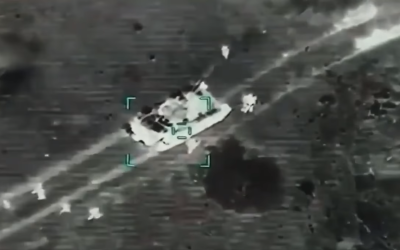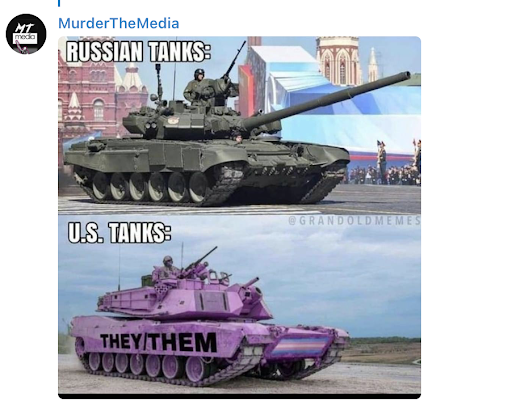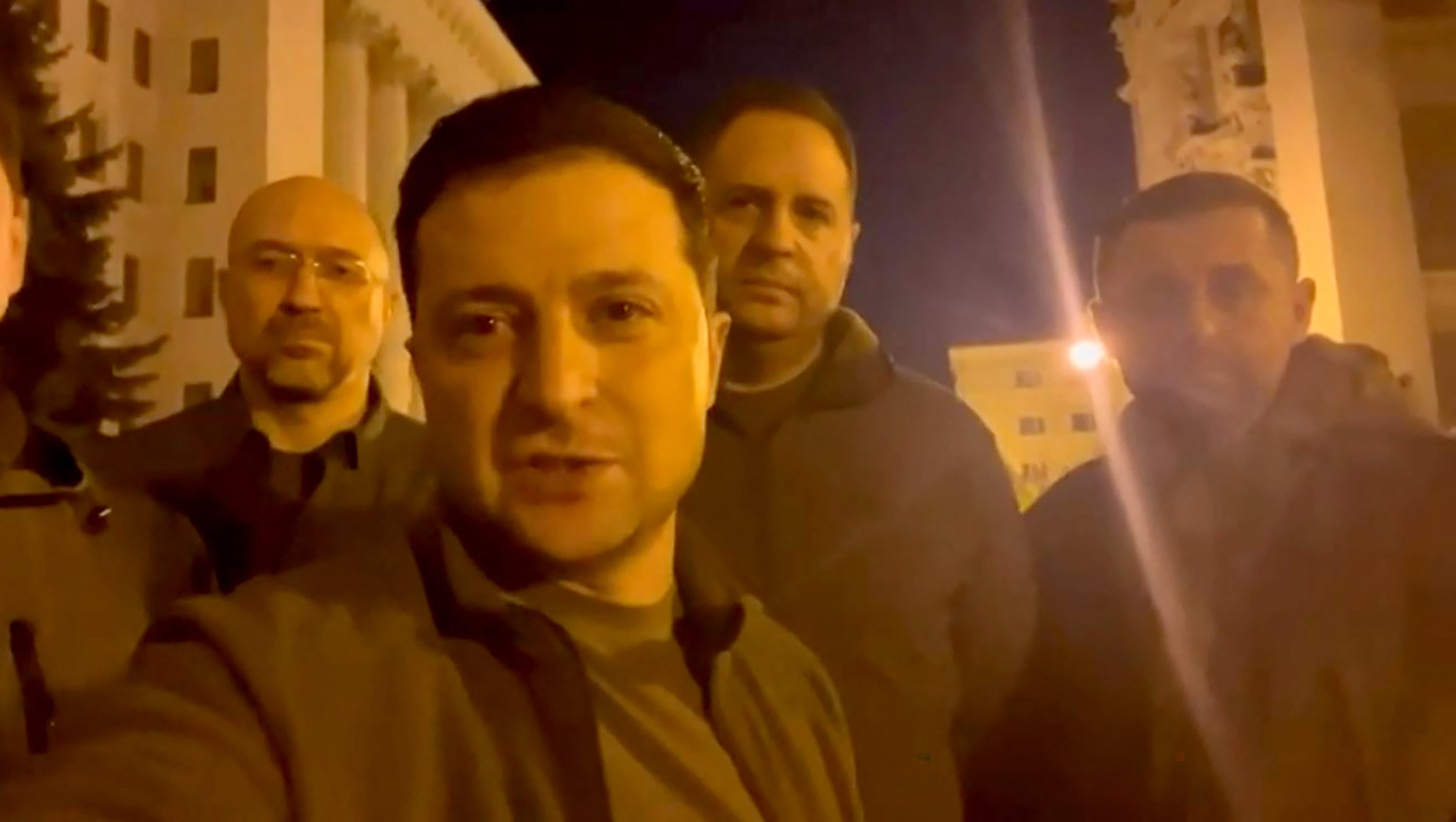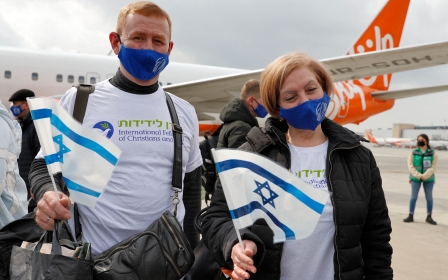Russia-Ukraine war: How social media became a battleground
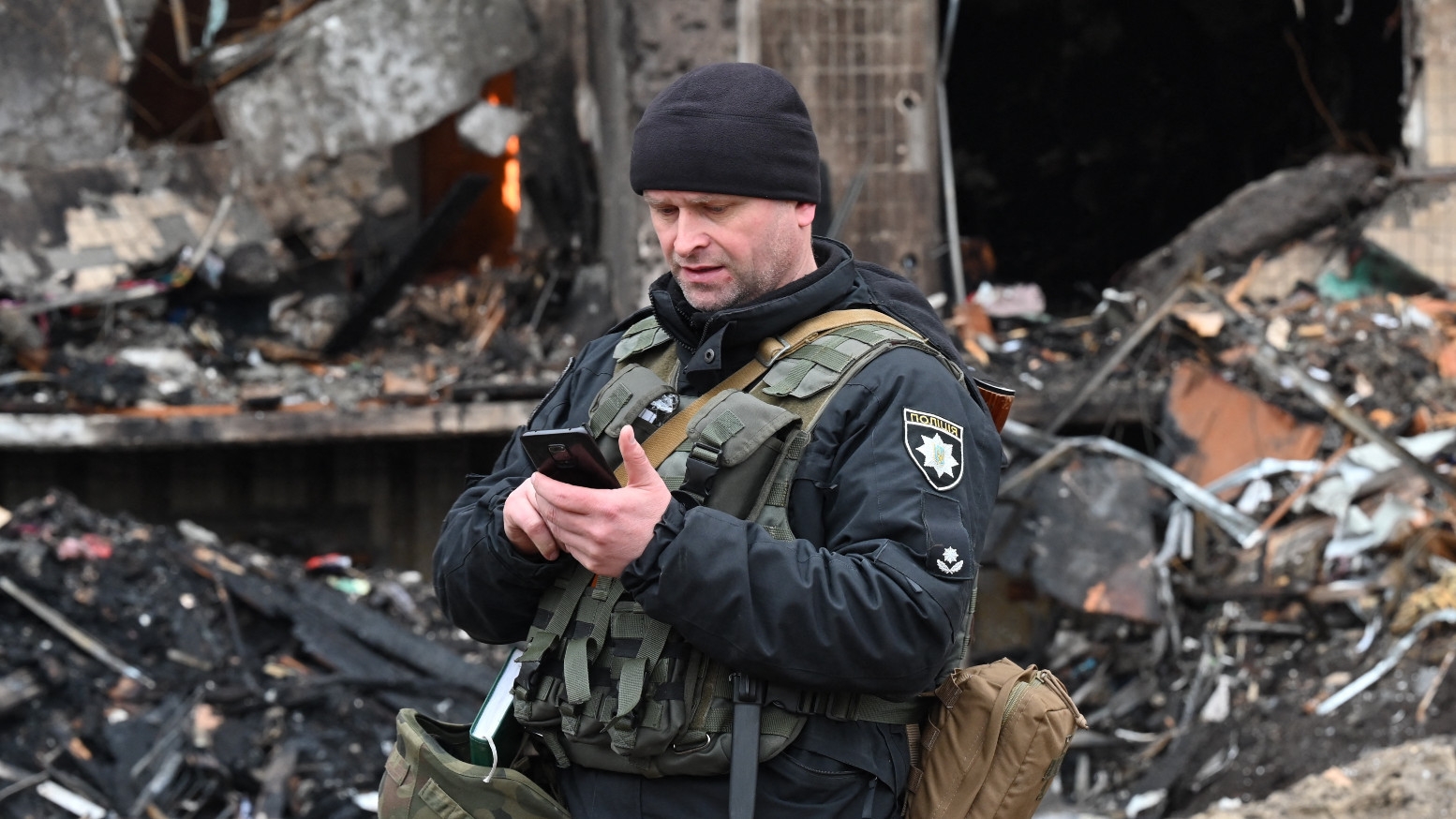
Russia’s invasion of Ukraine is not the first social media war, as some pundits have disingenuously claimed.
Digital platforms were credited with having an impact during the Arab Spring in 2011. In Syria, medics sent live updates from hospitals as - often Russian - bombs fell, and Twitter users published videos showing the destruction of their hometowns.
But perhaps for the first time in Europe, war is playing out in the age of TikTok viral challenges and Instagram “how you can help” explainers.
As Moscow continues its assault on Ukrainian cities, social media has become its own battleground.
The conflict is posing big questions for tech companies in how they deal with extremism, incitement to violence, disinformation, and propaganda - their answers will reverberate far beyond this conflict.
New MEE newsletter: Jerusalem Dispatch
Sign up to get the latest insights and analysis on Israel-Palestine, alongside Turkey Unpacked and other MEE newsletters
Here's how the social media warfare has unfolded in the past week:
Ukrainian resistance
As Ukrainians sought to fend off Russian invaders across their cities, social media became a key tool for promoting ways for civilians to fight back and resist.
A feature of the past week has been Ukrainian officials encouraging its citizens to use Molotov cocktails against Moscow’s soldiers - and posting detailed instructions on how to make them.
Former Ukrainian Prime Minister Volodymyr Groysman posted a two-minute video of himself making the improvised weapon.
Ukraine’s official Land Forces Facebook account posted a Molotov recipe under the caption “Saturday cocktail menu for patriots”.
The blue-ticked National Security and Defence Council of Ukraine posted the same infographic on Twitter, while the interior ministry posted its own recipe across all its social platforms.
At one point, a Jesuit priest took to Twitter to give out advice on how to destroy a tank using a Molotov cocktail.
The use of digital platforms to share ways in which to violently resist aggression from a nation state’s military could set a precedent.
According to Twitter’s terms of service on violent threats, “you can’t state an intention to inflict violence on a specific person or group of people”, which includes “threatening to seriously hurt someone and/or commit a… violent act that could lead to someone’s death or serious physical injury”.
There is no indication that this policy changes in war or fighting in self-defence.
Meta urges its users not to post instructions on how to make weapons unless the content is shared as part of recreational self-defence, military training purposes, video games, or news coverage.
On the specific issue of instructions on making explosives, it urges users not to do so “unless there is clear context that the content is for a non-violent purpose”.
Middle East Eye reached out to Twitter and Meta to ask about their approach to posts inciting violence, including Motolov cocktail recipes. Twitter did not respond, while Meta said it had nothing further to share.
Several commentators have questioned whether Palestinians using Molotov cocktails to resist Israeli aggression would be met with the same response on social platforms.
“I’ve always advocated non-violent mass resistance, but why are Ukrainians wielding Molotov cocktails seen as heroes while this week Israeli forces shot dead a 14 yr old boy (they called him a terrorist) for throwing one at settlers who have illegally taken Palestinian land?” asked James J. Zogby, founder of the Arab American Institute.
Elsewhere, Ukrainians posted an old video on TikTok of Moscow-based influencer Nastya Tuman teaching users how to drive Russian armoured personnel carriers.
Tuman reposted the video last week with the caption: “if you happen to find a free or abandoned armoured personnel carrier, here’s a life-hack on how to start it.” It appeared to be a show of solidarity towards Ukrainians.
An urban warfare expert also shared a much-lauded thread giving advice to Ukrainian civilians on how to fight back against Russian troops.
It included tips on the best positions to shoot firearms from, how to use Molotov cocktails to destroy artillery, and how to strike fear into soldiers by feigning ownership of a sniper.
Yonah Lieberman, founder of Jewish human rights group If Not Now, tweeted that if that thread had been posted during Israel’s war on Gaza in 2014 or the US invasion of Iraq, the author “would be out on a terror watch list”.
Fake footage and disinformation
While social media has proven an invaluable source of information and live updates from Ukraine, it has also been used to spread fake and misleading material.
Last week, Ukraine’s army shared a video which it claimed showed Turkish Bayraktar TB2 drones destroying Russian military equipment. The footage in fact showed the same unmanned weapon targeting a Syrian government convoy two years ago in the Idlib province.
Meta launched an investigation into the video after MEE reached out for comment. It has since been taken down by the Ukrainian account.
Elsewhere, viral videos which originate from Libya, Lebanon and Palestine have been falsely attributed to the Ukraine invasion.
Old footage of Palestinian activist Ahed Tamimi was also posted online under the false claim that she was a Ukrainian girl standing up to a Russian soldier.
Ukraine’s defence ministry shared footage it claimed showed a jet shooting down a Russian warplane - but the clip was actually from a video game.
TikTok became a major source of misinformation, with some users doctoring old audio in an attempt to create monetised livestreams by claiming to be in Ukraine.
“As is almost always the case in times of war, the online information environment becomes polluted incredibly quickly,” Layla Mashkoor, associate editor at the Atlantic Council's digital forensic research lab, told MEE.
“Old and recycled videos begin circulating online, sometimes innocently by people who don’t know better, and other times by malicious actors seeking to sow panic and chaos.”
On Monday, Meta announced that it had taken down a pro-Russian disinformation network which consisted of 40 fake accounts, groups and pages across Facebook and Instagram.
The network used AI-generated profile pictures to masquerade as aviation engineers, news editors, scientific authors, among others, claiming to be in Kyiv.
Meanwhile, a senior Russian official posted what he believed to be evidence of CNN claiming that a journalist had been killed in both Ukraine and Afghanistan. But the claim was completely false and has been debunked.
Moscow has repeatedly been accused of using doctored and misleading footage to justify its invasion, which open source intelligence invesigators have been picking apart.
Far-right content
When President Vladmir Putin launched Russia’s invasion of Ukraine, he said it was aimed at “demilitarisation” and “denazification” of the country.
It was an incendiary claim in a country whose president, Volodimir Zelensky, is Jewish and lost relatives during the Holocaust.
On Tuesday, Russia struck the Babyn Yar memorial site in Kyiv, where Nazis killed tens of thousands of Jews during World War II.
The repeated references to Nazis by Russian officials are linked to far-right ultra-nationalist elements within the Ukrainian army.
The presence and activity of such groups on social media has been a major headache for big tech companies over the past week.
Amid Russia’s invasion, Facebook temporarily allowed users to praise the neo-Nazi Azov Battalion, a Ukrainian military group that has previously been banned from being discussed on the platform under its Dangerous Individuals and Organisations policy.
The voluntary military unit, which was formed in 2014, is accused of holding neo-Nazi and white supremacist views. It was officially integrated into Ukraine’s army a few months after its formation and praised by former President Petro Poroshenko.
Azov troops often train in military uniforms adorning Nazi symbols, including the Totenkopf “death’s head” symbol, the Wolfsangel, an ancient runic symbol believed to ward off wolves popularised during the Third Reich, and the Sonnerad (Black Sun symbol), which was appropriated by Nazis in an attempt to invent an Aryan heritage.
According to internal policy materials seen by The Intercept, Facebook will now allow users to praise the Azov Battalion in the context of its role defending Ukraine.
This would be the latest example of Facebook temporarily changing policies based on current affairs - last year it briefly lifted a ban on users in Iran posting “Death to Khamenei” amid anti-government protests.
The Azov group will still be banned from using the platform, and its uniforms and banners will still be considered to be hate symbols.
On Sunday, the official Twitter account of Ukraine’s National Guard tweeted: “Azov fighters of the National Guard greased the bullets with lard against the Kadyrov orcs.”
The discriminatory tweet was in reference to bullets being coated with pig fat to be used against Muslim Chechen soldiers led by Ramzan Kadyrov.
“Dear Muslim brothers. In our country, you will not go to heaven. You will not be allowed into heaven. Go home, please. Here, you will encounter trouble. Thank you for your attention, goodbye,” a man coating the bullets is seen saying in the accompanying video.
Twitter restricted the tweet from the National Guard, but kept it up on its platform.
“This Tweet violated the Twitter Rules about hateful conduct. However, Twitter has determined that it may be in the public’s interest for the Tweet to remain accessible,” a message overlaying the tweet now reads.
While the far-right Azov group faces restrictions on Facebook and Twitter, it appears to be freely utilising Telegram.
Flashpoint, an intelligence organisation which monitors threatening internet activity, identified that the group had been using the platform for recruitment purposes.
Telegram has long been accused of being a favourite platform for right-wing extremists, playing a key role in the riot on the US Capitol by supporters of former President Donald Trump, and being used by right-wing Israeli groups to organise 'lynchings' of Palestinian citizens of Israel during last year's escalation of violence.
Over the past week, right-wing Americans have taken to Telegram to express support for Putin and use discriminatory language to criticise its own government.
A popular podcast channel called 'Murder the Media' celebrated Russian tanks, while denouncing Washington by photoshopping a US tank with a transgender solidarity flag and the pronouns "they/them".
“Putin’s military gets Ukraine,” Arizona state Senator Wendy Rogers said on her channel. “Our military gets trannies and face masks.”
Russian de-platforming
Digital platforms have become a key tool to control the narrative, domestically and internationally, about the war effort.
A widely shared infographic showing a map of “airstrikes in the last 48 hours” highlights Israeli strikes in Syria, Saudi airstrikes in Yemen and the US targeting Somalia, in addition to Russia’s attack on Ukraine. The caption reads: “Condemn war everywhere”.
It seems a good point well made, but the graphic was created by redfish, a media organisation which presents itself as grassroots, but is backed by the Kremlin.
For Russia, state-affiliated media outlets are a key tool in its information warfare - but the military escalation of the past week has led to mass de-platforming.
The EU announced on Sunday that Russian state media outlets would be banned from airing across the trading bloc.
“The state-owned Russia Today and Sputnik, and their subsidiaries, will no longer be able to spread their lies to justify Putin’s war,” said EU Commission President Ursula von der Leyen. “We are developing tools to ban their toxic and harmful disinformation in Europe.”
The ban quickly began to take effect: Meta’s Nick Clegg announced that Russian state outlets RT and Sputnik would be blocked across the EU on Facebook and Instagram.
TikTok followed suit, as did YouTube. Twitter initially stopped short of an outright ban, opting to add a state media label to any links shared from Russian-affiliated media. But on Wednesday it announced that it would comply with the EU order.
“The state-owned Russia Today and Sputnik, and their subsidiaries, will no longer be able to spread their lies to justify Putin’s war”
- Ursula von der Leyen, EU Commission president
Russia has responded by heavily restricting access to Facebook and Twitter since the war broke out.
The Kremlin is now attempting to further censor big tech companies at home by forcing them to set up legal entities within the country.
Civil society groups have warned that the move would leave companies open to Russia’s legal system, restricting freedom of expression and privacy.
It's an effort by Moscow to control the narrative at home - as it continues to lose its platforms to do so internationally.
For Ukraine, President Zelensky has been described as “the first wartime hero of the social media age”.
Long before the war, the former actor and comedian recognised the power of social media to widen his appeal and transform from an on-screen president to real-life one. Now his defiant selfie videos from the streets of Kyiv have turned him into a global sensation.
Over the weekend, he took to Twitter to thank Turkish President Tayyip Erdogan for closing the Black Sea to Russian warships. But Turkish officials told MEE that they had made no such decision - it appears to have been a ploy by Zelensky to use social media to force Turkey’s hand.
Russia's bombing of Kyiv's media tower, which resulted in five deaths, has been viewed by many as a deliberate attack on free expression and communications on the ground (something Israel was accused of doing last year when it bombed a media tower in Gaza).
As the war rages on, the attack on the tower is a stark reminder of the lengths being taken to try to win the information battle.
This article is available in French on Middle East Eye French edition.
Middle East Eye delivers independent and unrivalled coverage and analysis of the Middle East, North Africa and beyond. To learn more about republishing this content and the associated fees, please fill out this form. More about MEE can be found here.


